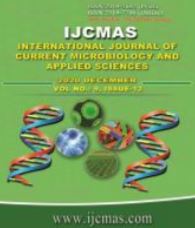


 National Academy of Agricultural Sciences (NAAS)
National Academy of Agricultural Sciences (NAAS)

|
PRINT ISSN : 2319-7692
Online ISSN : 2319-7706 Issues : 12 per year Publisher : Excellent Publishers Email : editorijcmas@gmail.com / submit@ijcmas.com Editor-in-chief: Dr.M.Prakash Index Copernicus ICV 2018: 95.39 NAAS RATING 2020: 5.38 |
In north interior Karnataka (NIK) maize is the major crop grown during kharif season and NK-6240 is a promising private hybrid used by farmers of this region. However, more often farmers fail to harvest potential yield. The yield gap analysis is very essential to quantify the difference between potential yield and actual yield of a given crop so that adaptations are devised to fill the gap. This plays very important role especially for the crops grown under rainfed conditions because the yield is limited more often by water stress followed by N stress in the rainfed conditions. Therefore, it is required to quantify the yield gap between potential and actual yield under rainfed conditions so that crop management strategies are developed to fill the gap. For this calibrated and validated DSSAT-CERES model was used to run seasonal analysis from 1988 to 2018 (31 years) for the maize hybrid NK-6240 under potential (no water stress) and rainfed conditions on black and red soils across 12 districts of NIK. Among the 12 districts on the black soil, the highest yield gap was simulated for Koppal district (63.5 %) and the least was for Belagavi district (0.0 %) whereas, on red soils the highest gap was simulated for Koppal district (55.2 %) and the least was for Haveri district (6.2 %). The simulated results showed that the average grain yield across soils and districts in rainfed conditions for NIK was 6906 kg ha-1 and when the crop was grown on moisture stress free conditions the yield improved on average for whole of NIK by 19.9 per cent at 8278 kg ha-1indicating that there is a scope to improve grain yield of maize in NIK by growing the crop under potential conditions compared to rainfed.
 |
 |
 |
 |
 |